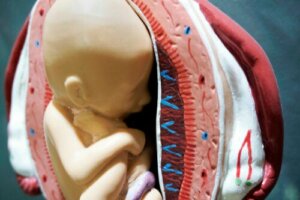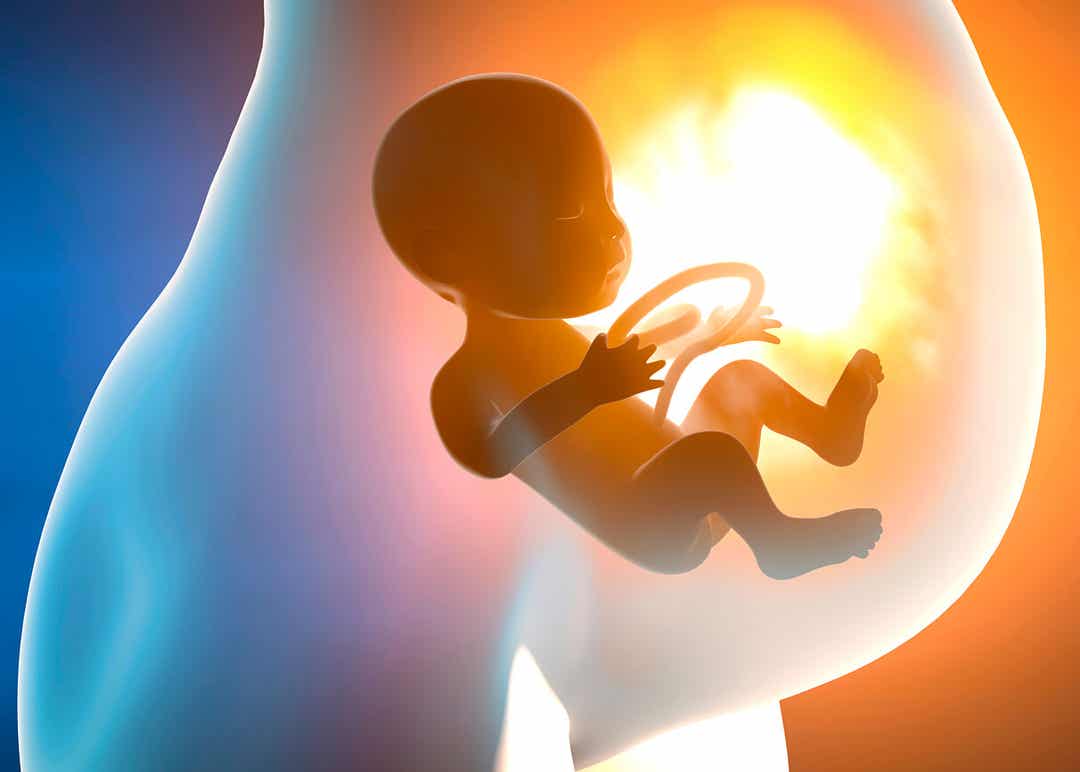The Gestational Sac: Basic Aspects

The gestational sac is one of the main tissues necessary for the proper development of the embryo or fetus during pregnancy. In fact, without it, gestation as we know it would be unfeasible, as both the future baby and the amniotic fluid are suspended inside it.
Its formation is complex and very interesting. However, in the following article, we’ll refer to some of the most basic aspects of this interesting structure. What’s it like? What are its measurements? And what’s it used for? Are you interested in learning more? Keep reading!
What is the gestational sac?

The gestational sac is a very important structure for pregnancy. That’s because it houses both the baby and the amniotic fluid that surrounds it. Like the uterus, it has a great capacity for expansion or elasticity that reaches its maximum length around the 35-37th week of pregnancy.
Its size depends very much on the week of gestation, as it increases progressively. In its early stages, it may measure a few millimeters in diameter, until it reaches a size large enough to house a fetus measuring around 20 inches, for example.
If you think of the sac as a kind of egg, the shell consists of a series of membranes. The innermost one – which is in contact with the amniotic fluid – is known as the amnion, while the outermost one is called the chorion.
Interestingly, the chorion communicates directly with and is, in a way, a prolongation of the placenta. This last organ is the main organ in charge of the future baby’s nutrition. This is thanks to the exchange of nutrients between the mother and the fetus due to the passage of blood.
What are the functions of the gestational sac?
The functions of the gestational sac aren’t limited to the membranes themselves, but also to the amniotic fluid it contains. For one, it actively participates in the development of the various organs of the embryo or fetus. And, at the same time, it provides support and protection in case of trauma or similar events.
Protection
Can you imagine what could happen to your baby if you were to receive direct impact to the abdomen? The gestational sac, thanks to the presence of the amniotic fluid inside it, allows cushioning many of the traumas in the area. This undoubtedly protects the baby and reduces the incidence of miscarriages and pathological events.
Promoting the development of the future baby

Although it’s common to think of the gestational sac as a lifeless structure, this isn’t the case. It actively participates in the nourishment of the future baby, as, in a way, its layers give rise to the placenta, one of the most important organs for gestation.
Thermoregulation
There are many factors that determine the regulation of body temperature within the gestational sac. The presence of the amniotic fluid, contained within the sac, is able to maintain constant temperature values to favor the proper growth of the embryo or fetus.
Of course, the latter also has its own thermoregulatory mechanisms. One of them is the appearance of a fine layer of hair on the surface of the skin, called lanugo, which allows it to better adapt to external changes.
Do you know about veiled birth?
Veiled births, also known as en caul birth, refers to the birth of a baby (either by natural childbirth or cesarean section) in which the rupture of the amniotic membranes doesn’t occur in the normal way. What’s the consequence? A rare and exciting event: the baby’s born inside the sac.
It’s generally not considered a risk for either the baby or the mother. However, the medical staff in charge will have to act fast in order to allow the sac to rupture. After this – if everything went well – the baby will take its first breath and start crying.
The gestational sac: a vital structure
It’s clear that, without a well-formed gestational sac, a successful pregnancy can’t take place. Although it’s not essential for a mother to know the details of this organ, it’s interesting to know how her body functions during pregnancy, which confirms that it’s a very complex and wonderful process, worthy of admiration!
The gestational sac is one of the main tissues necessary for the proper development of the embryo or fetus during pregnancy. In fact, without it, gestation as we know it would be unfeasible, as both the future baby and the amniotic fluid are suspended inside it.
Its formation is complex and very interesting. However, in the following article, we’ll refer to some of the most basic aspects of this interesting structure. What’s it like? What are its measurements? And what’s it used for? Are you interested in learning more? Keep reading!
What is the gestational sac?

The gestational sac is a very important structure for pregnancy. That’s because it houses both the baby and the amniotic fluid that surrounds it. Like the uterus, it has a great capacity for expansion or elasticity that reaches its maximum length around the 35-37th week of pregnancy.
Its size depends very much on the week of gestation, as it increases progressively. In its early stages, it may measure a few millimeters in diameter, until it reaches a size large enough to house a fetus measuring around 20 inches, for example.
If you think of the sac as a kind of egg, the shell consists of a series of membranes. The innermost one – which is in contact with the amniotic fluid – is known as the amnion, while the outermost one is called the chorion.
Interestingly, the chorion communicates directly with and is, in a way, a prolongation of the placenta. This last organ is the main organ in charge of the future baby’s nutrition. This is thanks to the exchange of nutrients between the mother and the fetus due to the passage of blood.
What are the functions of the gestational sac?
The functions of the gestational sac aren’t limited to the membranes themselves, but also to the amniotic fluid it contains. For one, it actively participates in the development of the various organs of the embryo or fetus. And, at the same time, it provides support and protection in case of trauma or similar events.
Protection
Can you imagine what could happen to your baby if you were to receive direct impact to the abdomen? The gestational sac, thanks to the presence of the amniotic fluid inside it, allows cushioning many of the traumas in the area. This undoubtedly protects the baby and reduces the incidence of miscarriages and pathological events.
Promoting the development of the future baby

Although it’s common to think of the gestational sac as a lifeless structure, this isn’t the case. It actively participates in the nourishment of the future baby, as, in a way, its layers give rise to the placenta, one of the most important organs for gestation.
Thermoregulation
There are many factors that determine the regulation of body temperature within the gestational sac. The presence of the amniotic fluid, contained within the sac, is able to maintain constant temperature values to favor the proper growth of the embryo or fetus.
Of course, the latter also has its own thermoregulatory mechanisms. One of them is the appearance of a fine layer of hair on the surface of the skin, called lanugo, which allows it to better adapt to external changes.
Do you know about veiled birth?
Veiled births, also known as en caul birth, refers to the birth of a baby (either by natural childbirth or cesarean section) in which the rupture of the amniotic membranes doesn’t occur in the normal way. What’s the consequence? A rare and exciting event: the baby’s born inside the sac.
It’s generally not considered a risk for either the baby or the mother. However, the medical staff in charge will have to act fast in order to allow the sac to rupture. After this – if everything went well – the baby will take its first breath and start crying.
The gestational sac: a vital structure
It’s clear that, without a well-formed gestational sac, a successful pregnancy can’t take place. Although it’s not essential for a mother to know the details of this organ, it’s interesting to know how her body functions during pregnancy, which confirms that it’s a very complex and wonderful process, worthy of admiration!
This text is provided for informational purposes only and does not replace consultation with a professional. If in doubt, consult your specialist.








